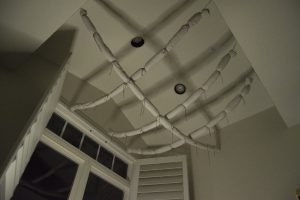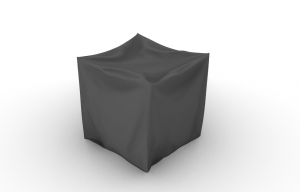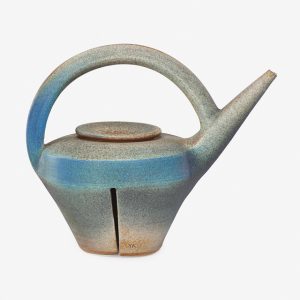7 Austin Kennedy on Karen Karnes
My name is Austin! I’m currently an atmospheric science major with a focus on climate at the University of Washington. I’m very concerned about the current condition of our climate (as many others are) and that’s why I have chosen to study it. Aside from academics, I’m also very interested in music production and filmmaking.
Karen Karnes (1925-2016) was an American ceramist known for her variations of traditional ceramics. She attended Brooklyn College and learned her craft at Alfred University before teaching at Black Mountain College. She is known for using the salt kiln in her ceramics.
Dear Karen Karnes,
My name is Austin. I’m a multimedia artist currently studying Atmospheric Sciences at the University of Washington in Seattle, and I just wanted to discuss some pertinent questions about the creative process, the role of art, and the interpretation of the finished product. I am not a ceramist, but I think that there are valuable comparisons to be drawn from your experiences to my filmmaking, music production, and visual art. Hopefully, through this letter, I can find more understanding or meaning behind my work, as you have a valuable perspective through your life of experience.

Through my work, particularly my musical projects, I have been curious about how experimentation during the creative process influences or directs the product. You talked about how you liked to experiment with the salt kiln and seeing how different materials react to the intense physical processes of the craft [1]. Although I cannot relate to this exactly (as I have never touched ceramics), there are many similarities to different artforms. Because you come from a strong technical background, having spent time perfecting your physical craft at Alfred University, I wonder what you think about inexperience as a form of experimentation. Personally, as a person who is new to visual art, I have found that my inexperience has led me to create in different ways that are not very conventional. I recently created a hanging carcass out of bed sheets, to symbolize my body and my separation from it. Due to my sewing inexperience, it is rough around the edges, and I spent a great deal of time experimenting with techniques that are not very conventional. Because of this, I think it gives the piece a very unique character. You being someone who spent many years perfecting your craft, then experimenting more after attending Black Mountain College, do you think that experience is necessary to effectively experiment with your art? Based on the Black Mountain College’s teaching methods, for example, Josef Albers focuses on materials, color, and form rather than intense technical background, I would expect that you support experimentation with inexperience [2]. This is concurrent with what you would say, as you express that it is not as important to have a strong technical background, but rather a strong perspective on the surrounding world. This is a statement I certainly agree with, and also how I would describe myself as an artist (as I am intentionally not a very technical artist).
You talk about how sometimes you start working on a product without actually knowing where it will lead you. Put differently, you start with one piece and slowly add more and more based on the feel of the current form of the object[3]. Coming from a background of mostly science and mathematics, I find this very difficult for me personally. I feel like I am very hardwired to determine the form of everything before I even start my project. For the longest time, I would say that most of my creative process would happen in my head, but now I realize that this is just a justification for one of my shortcomings. If I’ve learned anything while creating my hanging carcass project, it is to learn to start. I spent so much time determining every exact measurement that I never really gave myself time to interact with differing materials. And when I finally started, I ended up scrapping most of those measurements anyways, instead of focusing on how it felt in person. Given your artwork and processes, I would think that you would agree that jumping off the deep end leads to some of your most valuable creations. These days I find myself doing more of my art behind my laptop. With artwork that is more computer-oriented, I think it is harder to jump into your work. Computers by nature are very logical and mathematical, so it feels less experimental and you need to know the exact methods to achieve what you want. This requires you to spend more time preparing in my opinion, but I would be curious to know what you think. I spend more time talking about computer aided design later on as well.
The use of a salt kiln is a very natural and considered process. Therefore, developing consistent rhythm is important to creating your ceramics I imagine. I know that you have expressed the importance of rhythm, and giving yourself time to gradually develop your project based on the developing mood of the piece. When creating my hanging carcass, I spent a great amount of time repeating the same stitches (a total of 8 hours of just sewing). Although this may seem to be painfully monotonous to some, it was more of an inspiring and flowing process to me. Much like you said, it gave me time to slowly decide the outcome of my project. You are given the time to form new ideas, envision and experiment. This also connects to what I said earlier about when to start your project. Instead of spending great amounts of time planning every nuance to the project, you should instead start and let the ideas and adjustments form during the natural rhythms of creation. Not only that but the act of sewing, much like the act of slowly assembling pieces of clay, is very calming and engaging to the individual. I believe, as you have also expressed, that letting natural pacing take over your workflow is important to the creative process.

I also feel like I can connect with what you said about the relationship between the artist and mass production. You talked about how it is difficult to keep yourself engaged when you are focused on the quantity of your work, and the intentional recreation of objects. In the context of our modern era, where objects can become easily reproduced and created with computers via advanced printing methods, I wonder if more and more artists focus on the reproducibility of their work. It’s hard to say that this makes the art less legitimate, but I think it’s counterproductive to the creative processes. As you said, it’s easy to hardwire your mind into an industrious setting when you create solely for an amount, and it’s hard to maintain that experimentation and creativity. At the same time, the difficulty to maintain profit as an artist pushes more people into this setting. Many people see commonly reproduced products less as artwork and more as functional objects. Many times, designers of mass produced clothing also think in this way. Instead of trying to create products that represent themselves and their creative vision, they will create based on what will sell. I don’t know if this takes away from the artistic value of the product, but I think it is unfulfilling for the artist and can make someone feel more like a factory than a creator. This echoes what you have previously said about how this leads to the loss of joy of creating and limited experimentation. Going off of the idea of the use of technology for production, I think it is important to consider if the use of computer aided design as art takes away from the aesthetics of craftwork. I know that a lot of this is discussion a deviation from your art style and era, but I am curious about your thoughts. When I had to complete a 3D printing project with computer aided design, I felt like I needed to step away from the conventional methods and try to simulate an object that behaved like it was a real cloth object under gravity. Using computer programs to create art is inherently less interactive, and I feel like this can also take away from the joy of creation (much like how mass production does). I’d imagine that these methods of creation would be difficult for you (as you have studied physical ceramics for your entire life), but would be curious about your opinions on using 3D printing to create ceramics (by printing clay).

When looking at examples of your art projects, particularly your later pieces, I noticed how you would intentionally cut a slit in conventional items, like vases, bowls, and teapots. I was just wondering why you created these pieces? Of course, cutting a slit out of it renders its initial function useless, so it raises questions on how we should interpret, use, or interact with the piece. When I created a small Basurita not long ago, I found freedom in the process of destruction. Going off of my feelings, I guess that you relished in the deconstruction of something you spent a great amount of time and energy creating. Therefore, the artwork wasn’t created for use or interpretation, but rather as a method of expression of the creator. With the teapot example, I imagine that after spending years and years making the same teapots over and over again, it felt only sane to completely ruin it once. I think that destruction is good in art, as it allows you to step back, take yourself less seriously and express or cope with feelings.
I’ve noticed how you’ve embraced imperfection in your work. You seem to understand how the use of the salt kiln is limiting in that you don’t always have control over the end product. It seems like in the process of doing this, it gives room for the end product to assume its form and identity. This is something I greatly admire. I feel like intentionally limiting yourself is a great way of challenging your creative process and thinking in different ways to achieve the end product that you want. In my music production, I always am limited by my equipment (which is very expensive these days). Despite this, I always find ways to work around these limitations and create unique sounds that I think perfect sounding equipment would have prevented. You also have gone on to talk about how the salt kiln prevents repetition. You can put the same object in the salt kiln a thousand times over and over again and you will end up with a different product each time. I wonder though if this damages the relationship between yourself and the art you create. Because you have less control over the finished product, does it feel less personal? It certainly feels less deliberate, and I think that using an intentionally imperfect process can sort of remove the artist from the art. When I created that cloth cube in Rhino (the CAD program), I was using simulations, so I felt like I had very little control of the outcome. The only aspect I could change is the parameters of the simulation, and therefore it felt like more of a creation of the program rather than my creation. Some of this might relate to my dislike for using computer programs (due to the limited interaction), but I wonder if this somehow relates to using a salt kiln.
I hope you can help me gain some insight into these issues but thank you for all,
Sincerely,
Austin Kennedy
Media Attributions
- Hanging Carcass © Austin Kennedy is licensed under a CC0 (Creative Commons Zero) license
- Cloth Cube © Austin Kennedy is licensed under a CC0 (Creative Commons Zero) license
- Karen Karnes, Teapot is licensed under a Public Domain license
- Shapiro, Mark, and Karen Karnes. Oral History of Karen Karnes. Other. Archives of American Art, Smithsonian Institution, August 9, 2005. ↵
- Creasy, Jonathan C. “‘The Pencil, the Brush, the Chisel’: Black Mountain College and the Practice of Writing.” Black Mountain College Museum and Arts Center, October 10, 2020. http://www.blackmountainstudiesjournal.org/bmc-and-the-practice-of-writing/ ↵
- Karnes, Karen. “Karen Karnes, A Conversation.” Studio Potter, n.d. https://studiopotter.org/karen-karnes-conversation. ↵

